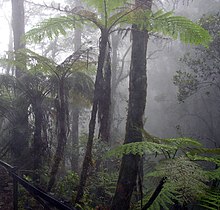
Back غابة ضبابية Arabic Планински екваториални гори Bulgarian Selva nebulosa Catalan Mlžný les Czech Tågeskov Danish Wolken- und Nebelwald German Nubarbaro Esperanto Bosque nuboso Spanish Pilvemets Estonian جنگل ابری Persian


A cloud forest, also called a water forest, primas forest, or tropical montane cloud forest, is a generally tropical or subtropical, evergreen, montane, moist forest characterized by a persistent, frequent or seasonal low-level cloud cover, usually at the canopy level, formally described in the International Cloud Atlas (2017) as silvagenitus.[1][2] Cloud forests often exhibit an abundance of mosses covering the ground and vegetation, in which case they are also referred to as mossy forests. Mossy forests usually develop on the saddles of mountains, where moisture introduced by settling clouds is more effectively retained.
Cloud forests are among the most biodiversity-rich ecosystems in the world, with a large number of species directly or indirectly depending on them.[3]
Other moss forests include black spruce/feathermoss climax forest, with a moderately dense canopy and a forest floor of feathermosses, including Hylocomium splendens, Pleurozium schreberi, and Ptilium crista-castrensis.[4] These weft-form mosses grow in boreal moss forests.[5][6]
- ^ Cite error: The named reference
Hostettlerwas invoked but never defined (see the help page). - ^ Sutherland, Scott (23 March 2017). "Cloud Atlas leaps into 21st century with 12 new cloud types". The Weather Network. Pelmorex Media. Retrieved 24 March 2017.
- ^ Cite error: The named reference
:0was invoked but never defined (see the help page). - ^ C. Michael Hogan, 2008. Black Spruce: Picea mariana, GlobalTwitcher.com, Nicklas Stromberg, ed.
- ^ Poller, Sonya (22 January 2015). "Alberta's Wonderful World of Bryophytes". Alberta Biodiversity Monitoring Institute Blog. Alberta Biodiversity Monitoring Institute.
- ^ Cullina, William (10 November 2020). "Gardening with Moss". Horticulture.